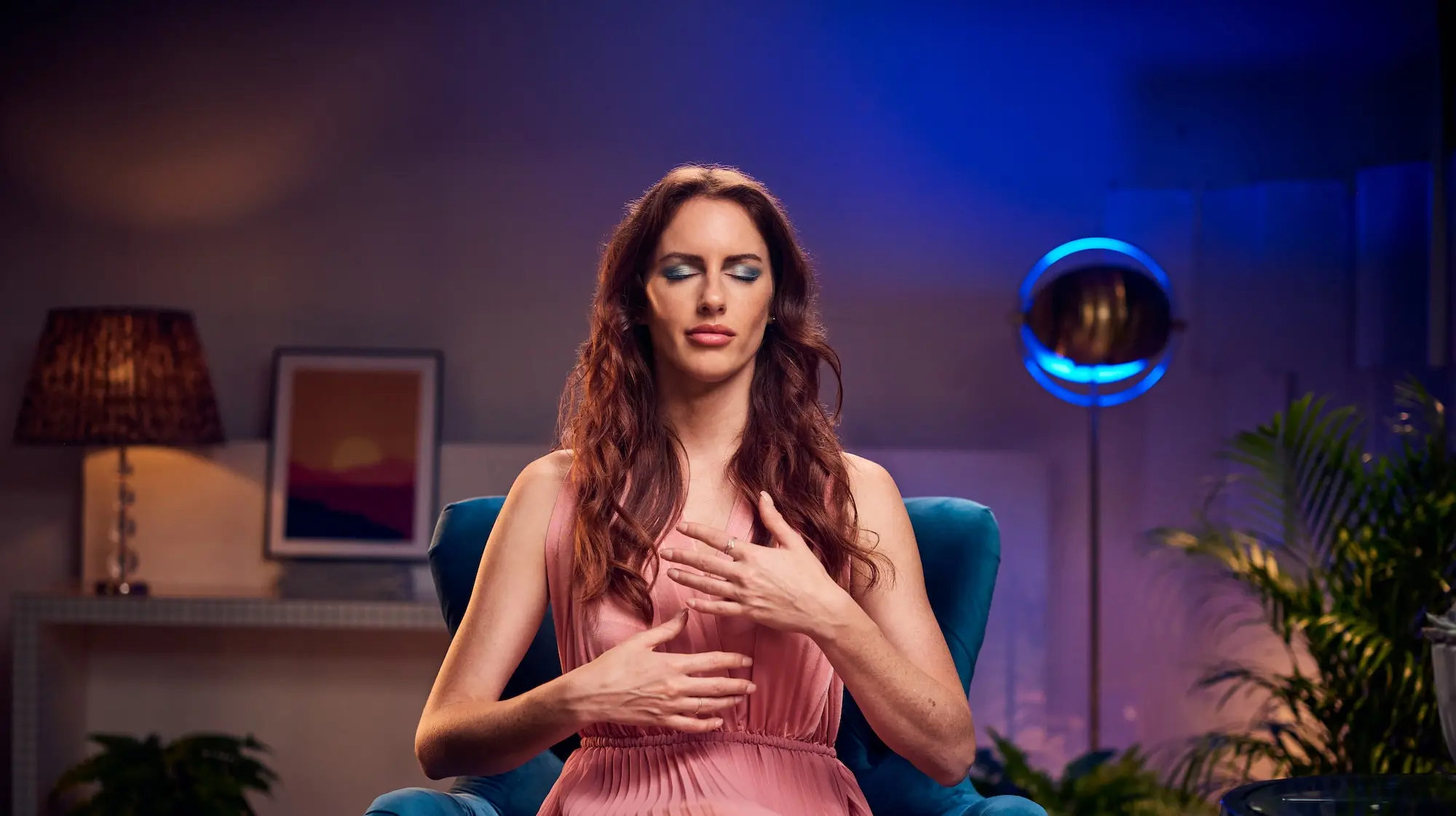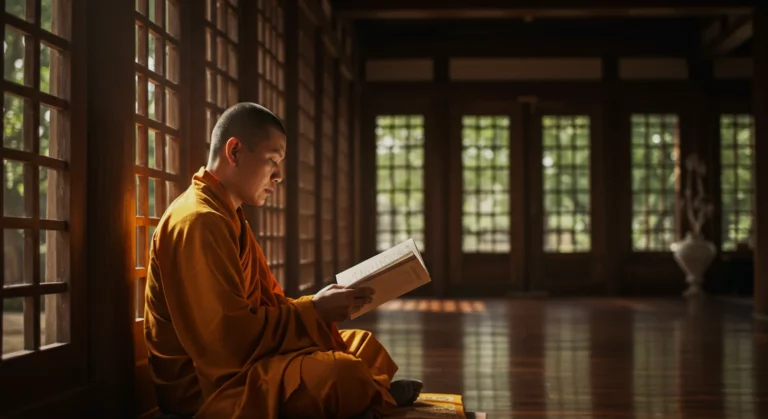Is astral projection real?
According to Jade Shaw, an advocate of altered states and the trainer of The Art of Astral Projection program on Mindvalley, it’s a hell yes.
And it’s likely you’ve been here before:
You wake up in the middle of the night, fully aware but frozen. You can’t move. You feel yourself floating. Then, you turn around and see your body lying below you. You’re out, but you’re dreaming. And you’re not dead either.
So, where are you?
Then it dawns on you: you’ve seen this scene a dozen times in horror films. The moment the soul leaves the body (and sometimes, it never comes back—cue the creepy music.
But before you gasp your socks off, ask yourself: what if the source material is true?
The reality is, thousands, like Jade, are doing it on purpose. And now, so can you.
What is astral projection?
Astral projection is the conscious act of your awareness leaving your physical body, on purpose, with full intent.
To Jade, it’s “a superpower hidden in plain sight” that anyone can access once they’ve learned how to tap into their body’s capacity for out-of-body experiences (OBEs). “You can springboard from a dream, a shamanic journey, or a deep meditation into one,” she adds.
And people have been doing it for thousands of years.
- The ancient Egyptians carved instructions for it on temple walls.
- Tibetan Buddhists train for it. Yogic texts describe it.
- Even the Central Intelligence Agency (CIA) studied it in a now-declassified program called The Gateway Experience in the name of intel-gathering beyond physical limits (with shockingly accurate results).
No wonder William Buhlman, a leading expert on OBEs, decided over four decades of life to teach and research astral projection. Through countless personal recollections and workshops at credible institutions like The Monroe Institute, he’s mapped the terrain of consciousness beyond the physical through this phenomenon.
As he wrote in his book, The Secret of the Soul, “We are multidimensional beings exploring a dense physical reality. Astral projection is remembering that truth.”
Astral projection: How it’s different from OBEs, lucid dreaming, and sleep paralysis
Most people confuse astral projection with OBEs and lucid dreaming, and for good reason. They all involve you exploring altered states of mind. So naturally, the line between them can blur.
But let’s break their differences down further:
| Phenomenon | What it is | Is it intentional? | Level of control | What it feels like |
| Astral projection | Conscious separation from the physical body | Yes | High (with practice) | You’re fully aware, moving through non-physical realms. |
| OBE | Spontaneous awareness outside the body | No | Low to medium | It just happens during sleep, trauma, and a near-death experience (NDE). |
| Lucid dreaming | Becoming aware you’re dreaming while still inside the dream | Yes (and it can be trained) | Medium to high | You’re in a dream knowingly, to the point of even steering it. |
| Sleep paralysis | Waking up mentally while the body stays frozen in REM sleep | No | None | You are stuck in your body, often with intense visuals or sensations. |
Each state unlocks a different door in consciousness. But unlike others, astral projection is the one that hands you the keys to your car and asks, “Where do you want to go?”
Is astral projection real, scientifically speaking?
While science hasn’t cracked the full code on astral projection, research has made one thing clear: the brain leaves a trace when consciousness “steps” outside the body. (That’s essentially OBE.)
Now, you can’t talk about one without unpacking the other. Because if astral projection is a road trip, then an OBE is the car engine that makes it possible.
Some neurologists think these episodes happen when your senses momentarily misfire. In one study, researchers stimulated the brain’s right temporoparietal junction, which helps you sense your body in space. The patient being studied reported floating above themselves, watching their body from the outside.
Other researchers have zoomed in on the role that brain waves play in an OBE. Another study found that the brain tends to be flooded with gamma, the frequency linked to memory and dreams, right before death. This could explain why so many NDE accounts are so vivid.
And research studying a person who could trigger out-of-body experiences at will discovered neural movements that are entirely new and not the ones associated with daydreaming, memory, or even normal imagining.
It’s no wonder that astral projection, CIA documents from the 1980s would reveal, was included in their consciousness-expansion research. They didn’t explain exactly how it worked and why it’s important, but they sure didn’t dismiss it either.
Is astral projection possible for anyone?
You don’t need to be a monk, a mystic, or halfway through a vision quest to leave your body. “If you are human, you can do this,” says Jade, adding that it’s as natural as breathing.
And here’s the kicker: it’s less to do with your belief about it and more about creating the right conditions for you to experience it. The rule of thumb to remember, she adds, is that “astral projection happens in an altered state of awareness.”
And it all starts with understanding how your brain works.
Here’s how to train for it:
- Start with deep relaxation.“If we don’t reach this, you’re not going to be able to astral project,” explains Jade. Meditation techniques, like a full body scan or non-sleep deep rest (NSDR), can help.
- Use other altered state experiences as launchpads. Remember, lucid dreaming, mindful breathing, and shamanic meditation can all “open the door” to the astral realm.
- Have a strong intention as your anchor. “Choose a meaningful motivation,” reminds Jade. “The universe is more likely to support the experience if you have a good reason.”
- Practice mind-body separation. Try Jade’s rope method (imagining yourself climbing upward out of your body) or the roll-out (visualizing your energy body sliding sideways out of bed). The point is to groom your awareness to slip away from the physical seamlessly while staying conscious.
- Track your shifts. Keep a journal that documents all of your dreams, sleep paralysis, or meditation insights. They’re clues to how well you can astral-project.
- Let it happen naturally. Don’t chase it. As Jade puts it, “OBEs are a byproduct of consistency, not effort.”
Do this consistently, and you’ll realize that astral projection isn’t for the spiritual elite. Nope—it’s for anyone and everyone who dares to expand their levels of consciousness.
Is astral projection dangerous or safe?
Astral projection isn’t dangerous. Well, not inherently. But the fear around it? That’s very real.
And it usually comes from two places: pop culture’s obsession with demons and possession or just plain old fear of the unknown.
And if you’re one to always wonder, “Is sleep paralysis astral projection?”, rest assured, they’re not the same thing. And to this, Jade assures: “You can never be harmed in a non-physical environment because there’s simply nothing to attack. There’s no body or no thing that can be harmed.”
Preparation, she says, is key. And here’s how you do it:
- Skip the supine position. Lying on your back increases the chances of sleep paralysis. And while it’s harmless, it can spiral into fear if you’re caught off guard.
- Create an intentional “container.” Before you start, set a clear intention for the experience. “Otherwise, you just end up floating around your room,” says Jade. Think of it as programming your internal GPS before takeoff.
- When in doubt, default to your body. If the vibe gets weird? Come back. Think of your body. Wiggle your fingers. Blink. You’ll snap right back in.
- Use fear as fuel. Jade teaches students to take a metta-moment—that is, dropping into the heart space with gratitude and compassion. This disarms fear fast. Have a mantra at hand, like “I release control,” “I surrender to the flow,” or “I am safe.”
- Call in your spiritual backup. This is where you’ll exercise creative visualization. Imagine a beam of light shooting into the cosmos, a signal for your spirit guides, ancestors, or higher self to step in. Feel yourself charged with positivity again.
- Use Jade’s go-to exit strategy. Here’s where you use the same rope method you would to trigger mind-body separation. Except now, you imagine your energy body grabbing the rope and pulling yourself upward whenever you want out.
You’re not flying blind—you’re built for this
Will you be in control? Yes, but not all the time. And “not over everything—just like in real life. You steer the ship, but you don’t control the ocean,” says Jade, adding that it’s perfectly okay.
What’s more important is knowing that you will always come back from a journey. Forget Hollywood’s fake scare tactics on-screen. “Your consciousness is [always] tethered to your body,” she adds. “Even needing to pee will pull you back.”
And done right, stepping out of your body teaches you what no book or belief system could: your consciousness has always known how to move beyond limits, sans inhibitions.
5 real-life stories on astral projection
Some people stumble into astral projection. Others train for it like a mental marathon.
But across decades and disciplines, these stories stack up. They prove that astral projection is anything but “fringe and cringe.”
Here are the notable few who have gone on the record about this larger-than-life experience:
1. Robert Monroe’s game-changing consciousness map
Robert Monroe didn’t just write about leaving his body; he turned it into a science. His book, Journeys Out of the Body, kicked off decades of research that led to the founding of The Monroe Institute. To date, the organization is one of the world’s top institutions studying altered states of awareness.
To help people navigate the astral space, Monroe came up with what he calls the “Focus Levels.” It’s a step-by-step map that takes you from a relaxed state (Focus 10) all the way to expanded realms of consciousness (Focus 21 and beyond).
Picture it as a ladder for consciousness, with each rung taking you deeper into the non-physical.
2. William Buhlman’s decades of out-of-body exploration
Buhlman’s first spontaneous OBE in his 20s sent him down a rabbit hole of self-experimentation. His book, Adventures Beyond the Body, has since become a field guide for consciousness explorers, stripping away mysticism and laying down techniques.
Today, through his work with The Monroe Institute, he’s helped thousands branch out into reality beyond the body on purpose.
We are multidimensional beings exploring a dense physical reality. Astral projection is remembering that truth.
— William Buhlman, author of Adventures Beyond the Body
3. Michael Crichton’s unconventional adventures
Ever wondered why Jurassic Park hit so deeply?
That’s because Michael Crichton, the author behind it, explored more than just dinosaurs and science. In his memoir, Travels, he wrote about his personal experiences with astral projection, detailing moments of observing scenes from a vantage point outside of his physical self.
The thing is, Crichton approached these altered states like research, documenting what happened and how it felt. For him, consciousness was just another frontier worth exploring. And it paid off: Jurassic Park became a bestseller, selling over nine million copies by 1993.
4. Oliver Fox’s lucid gateway to projection
Long before brain scans and CIA docs, British writer and occultist Oliver Fox (whose real name is Hugh George Callaway) was charting the astral world from his own bedroom in the early 1900s. His book, Astral Projection: A Record of Out-of-the-Body Experiences, reads like a field manual for the mind.
But here’s the thing: he didn’t stumble into astral projection. He trained for it. He experimented with techniques like dream recall and waking up in REM sleep, recording his results in a journal. A century later, his methods still echo in modern astral practices performed by lucid dreaming and dream yoga communities worldwide.
5. The Mindvalley community’s foray into the astral realm
At Mindvalley, authors, coaches, creatives, and seekers come together to share experiences and push the edges of consciousness, one projection at a time.
Explore some of their fascinating accounts after exploring The Art of Astral Projection:
Vanda Pereira’s creative awakening
Vanda, a Portugal-based author and coach didn’t just expand her consciousness for the sake of it. “The area of life where I noticed the greatest change was the professional realm,” she said.
After pairing lucid dreaming with astral practices, she became more confident in her psychic abilities and tapped into new depths of self-awareness. The result: a greater connection with her clients in the workshops and sessions she delivers.
Manas’ mental reset
For Manas, a Mindvalley member based in Kolkata, India, astral projection was the missing link to a fulfilling life based on a connection to self and others.
“The program changed the way I looked at life and humans,” he shares. Inspired by Robert Monroe’s idea that “you are more than your physical body,” he now carries a deeper belief in human potential—and a skill set to access it.
Monica Ducu’s cosmic expansion
Monica, a business accelerator coach in Romania, used the astral projection tips from Jade’s program as a portal to deeper insights.
One session, for one, brought her face-to-face with Osho in a telepathic conversation. Another guided her into a “place of eternal healing” that she now accesses anytime she needs renewal.
If there’s one takeaway she’s learned from Jade’s guidance, it’s this: “Why play small when the universe has endless possibilities?”
Expand your consciousness
“Fear is a natural reaction to moving closer to the truth,” said Buddhist nun Pema Chödrön once.
And this statement speaks volumes about the point of astral projection: that you won’t know your deepest truths until you dare explore reality beyond your day-to-day senses.
Avoiding fear, Jade says, has consequences. But facing them leads to your freedom.
And jumpstarting your journey to liberation can begin with her free Mindvalley masterclass, The Art of Astral Projection. In this session, you’ll unpeel many layers to this ancient self-discovering technique, including:
- The real reason the world’s waking up to this practice,
- The four-step approach to “travel” fast and easily,
- How multiversal exploration can transform your physical life,
- Advanced projection methods (if you’re a seasoned explorer), and
- So much more.
As Jade puts it succinctly, “In the OBE state, we can become our own shaman.” So, consider this an invitation to embrace your self-initiation and step into the version of you that remembers what it means to be limitless.
Welcome in.








